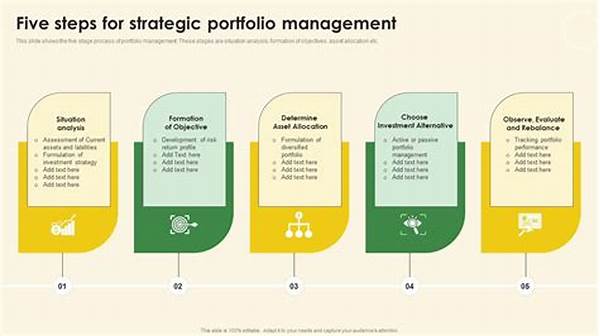The evaluation and enhancement of an individual’s portfolio are pivotal to one’s professional development, particularly in fields that heavily rely on visual representation such as design, marketing, and photography. A comprehensive portfolio critique involves the methodical analysis of one’s work collection to identify strengths, weaknesses, and opportunities for improvement. This practice not only aids professionals in showcasing their best work but also facilitates continuous professional growth. In a rapidly evolving market, staying relevant is crucial and having a sharp, well-organized portfolio is integral to this goal. Implementing improvement strategies thus ensures that one’s portfolio remains a true reflection of current skills, creativity, and adaptability.
Read Now : Holistic Employee Skill Enhancement Programs
Importance of Regular Portfolio Critique
Regular portfolio critique is essential for maintaining professionalism and competitiveness in the dynamic labor market. It involves soliciting feedback from peers, mentors, and industry professionals who provide objective insights into the quality and impact of the work presented. Such feedback is invaluable, offering an external perspective that the portfolio owner may overlook. Improvement strategies derived from these critiques enable individuals to refine their work, adapt to industry trends, and discard outdated pieces that no longer illustrate their professional growth. Consistently updating and honing a portfolio through systematic critique ensures that it remains aligned with personal career goals and industry expectations.
Strategies for Portfolio Improvement
1. Seek Diverse Feedback: Engaging with a varied audience for critique will yield a broad range of insights, enhancing the overall quality and appeal of the portfolio.
2. Focus on Quality Over Quantity: Highlight select pieces that underscore your strengths and skill diversity, rather than flooding with numerous less impactful works.
3. Incorporate Trending Techniques: Stay abreast of industry trends and integrate relevant techniques or styles that can place your work at the forefront of innovation.
4. Personal Branding Consistency: Ensure that your portfolio’s visual style and content consistently reflect your personal brand and professional narrative.
5. Reflect and Revise Regularly: Dedicate time to routinely assess your portfolio against current career objectives, revising and updating as necessary to maintain relevance.
Read Now : Streamlined Expense Report Approval
Challenges in Portfolio Critique
There are several challenges in conducting an effective portfolio critique. Understanding one’s own biases is imperative to conducting a balanced evaluation of the work included in the portfolio. Portfolio critique and improvement strategies must account for not only personal preferences but also industry standards and audience expectations. Additionally, the critique process can sometimes be subjective, making it difficult to discern which feedback is actionable. Developing the skill to differentiate between constructive criticism and biased opinions is, therefore, key to effective portfolio enhancement.
Methods to Implement Improvement Strategies
Implementing portfolio critique and improvement strategies requires a structured approach. Firstly, setting clear objectives for what you want to achieve with your portfolio can guide the critique process. Utilizing templates or guidelines specific to your industry can provide a benchmark for evaluation. Moreover, scheduling regular reviews, whether quarterly or biannually, can instill a discipline of continuous improvement. Visual comparison tools and peer review platforms can also serve as effective resources to measure your portfolio against industry standards and emerging trends. Regular education and training in your field will keep you informed of evolving standards and inspire innovative alterations in your portfolio.
The Impact of a Leveraged Portfolio
An optimally critiqued and updated portfolio can significantly impact career progression. By engaging in thorough portfolio critique and improvement strategies, professionals position themselves robustly within their industry. A well-curated portfolio effectively communicates one’s skills and achievements, often serving as a decisive factor in securing new opportunities, clients, or advancements. Moreover, the process of refining one’s portfolio enriches the professional’s understanding of their work, honing not just the presentation but the very skills it represents. Consequently, diligent application of critique and improvement strategies can elevate both the quality and perception of one’s professional portfolio.
Conclusion of Portfolio Critique and Improvement
In summary, engaging in portfolio critique and improvement strategies is not merely about the aesthetics of one’s work collection; it extends to fostering a professional journey marked by growth, adaptation, and self-awareness. A commitment to this process equips individuals to clearly and compellingly convey their evolving expertise, meeting the ever-changing expectations of their respective industries. By embracing feedback, setting strategic goals, and persistently refining their work, professionals ensure that their portfolios serve as enduring testaments to their abilities and aspirations, paving the way for long-term career success.
